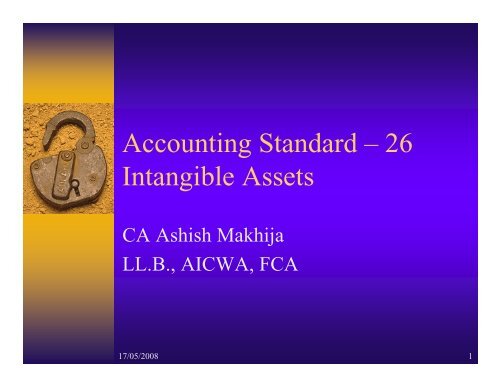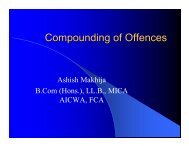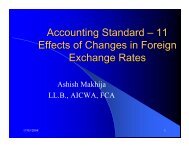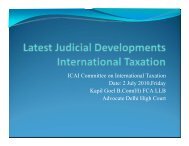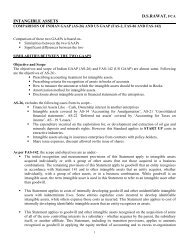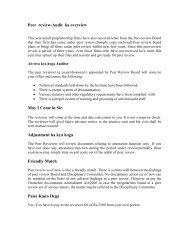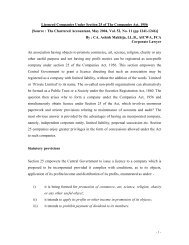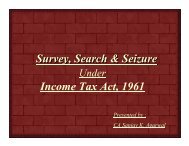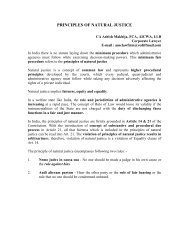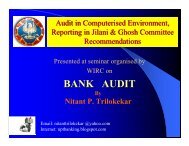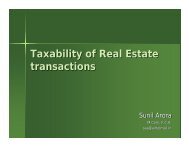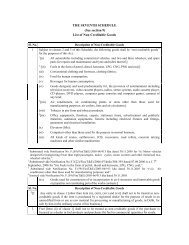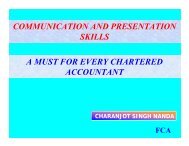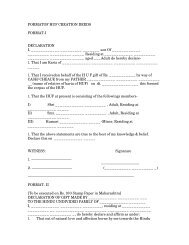Accounting Standard â 26 Intangible Assets - tnkpsc.com
Accounting Standard â 26 Intangible Assets - tnkpsc.com
Accounting Standard â 26 Intangible Assets - tnkpsc.com
Create successful ePaper yourself
Turn your PDF publications into a flip-book with our unique Google optimized e-Paper software.
<strong>Accounting</strong> <strong>Standard</strong> – <strong>26</strong><br />
<strong>Intangible</strong> <strong>Assets</strong><br />
CA Ashish Makhija<br />
LL.B., AICWA, FCA<br />
17/05/2008 1
Objective<br />
1. To prescribe accounting<br />
treatment for intangible assets<br />
2. Prescribe recognition criterion<br />
3. Prescribe Measurement of<br />
<strong>Intangible</strong>s<br />
4. Disclosure<br />
17/05/2008 2
Status<br />
♦ For <strong>Accounting</strong> Periods <strong>com</strong>mencing on or<br />
after 1.4.2004 – Mandatory for all<br />
enterprises<br />
17/05/2008 3
<strong>Accounting</strong> <strong>Standard</strong>s<br />
Withdrawn<br />
♦ AS 8 – <strong>Accounting</strong> for Research &<br />
Development<br />
♦ AS 6 – Depreciation <strong>Accounting</strong> with<br />
respect to the amortisation of intangible<br />
assets<br />
♦ AS 10 – <strong>Accounting</strong> for Fixed <strong>Assets</strong> –<br />
paragraphs 16.3 to 16.7, 37 and 38<br />
17/05/2008 4
Scope<br />
To be applied by all enterprises in<br />
accounting for intangible assets except<br />
– <strong>Intangible</strong> assets covered by another AS<br />
– Financial assets<br />
– Mineral rights & expenditure on the exploration<br />
for, or development and extraction of, minerals,<br />
oil, natural gas and similar non-regenerative<br />
resources<br />
– <strong>Intangible</strong> assets in insurance <strong>com</strong>panies<br />
17/05/2008 5
What Is <strong>Intangible</strong> Asset ?<br />
<strong>Intangible</strong> asset<br />
–An identifiable non-monetary asset<br />
– Without physical substance<br />
– Held for use in the production or<br />
supply of goods or services, for rental<br />
to others, or for administrative<br />
purposes<br />
17/05/2008 6
Asset<br />
Resource<br />
Controlled by an enterprise<br />
Expectation of future economic<br />
benefits<br />
17/05/2008 7
Recognition of <strong>Intangible</strong> Asset<br />
♦Falls within the ambit of definition of<br />
intangible asset, and<br />
♦Probability of future economic benefits<br />
flowing to the enterprise, and<br />
♦Reliable measurement of cost<br />
17/05/2008 8
Assessment of Probable Future<br />
Economic Benefits<br />
♦ Reasonable & supportable assumptions<br />
representing best estimate of economic<br />
conditions,over useful life<br />
♦ Evidence available at the time of initial<br />
recognition<br />
♦ Greater weight to external evidence<br />
17/05/2008 9
Initial Measurement of <strong>Intangible</strong><br />
Asset<br />
Initially to be valued at cost<br />
♦ Separate Acquisition<br />
♦ Acquisition as part of an amalgamation<br />
♦ Acquisition by by way of a Government Grant<br />
♦ Exchange of <strong>Assets</strong><br />
♦ Internally Generated Goodwill<br />
♦ Internally Generated <strong>Intangible</strong> <strong>Assets</strong><br />
17/05/2008 10
Cost of Internally Generated<br />
<strong>Intangible</strong> Asset<br />
♦ Research Phase<br />
– Expensed off on incurrence<br />
♦ Developmental Phase<br />
– Technical feasibility of <strong>com</strong>pleting the intangible asset<br />
– Intention to <strong>com</strong>plete the intangible asset and use or sell<br />
it<br />
– Ability to use or sell the asset<br />
– Probable future economic benefits<br />
– Availability of adequate resources to <strong>com</strong>plete the<br />
development<br />
– Ability to reliably measure expenditure during<br />
development<br />
17/05/2008 11
Cost of an Internally Generated<br />
<strong>Intangible</strong> Asset<br />
♦ Directly attributable or<br />
reasonably allocable<br />
expense to create, produce<br />
or making the asset ready<br />
for its intended use<br />
♦ Can include<br />
– Expenditure on material and<br />
services used or consumed<br />
– Direct personnel cost<br />
– Directly attributable<br />
expenditure<br />
– Allocable overheads<br />
♦ Does not include<br />
– Selling, administrative<br />
and general overheads<br />
– Clearly defined<br />
inefficiencies and<br />
initial operating losses<br />
before asset achieves<br />
planned performance<br />
– Expenditure on<br />
training of staff to<br />
operate that asset<br />
17/05/2008 12
Recognition of an Expense<br />
♦ Expense to be recognised when incurred, unless<br />
– Forms part of cost of intangible asset<br />
– Acquired in an amalgamation in nature of purchase,<br />
formed part of goodwill/capital reserve<br />
♦ Part Expense to recognised as part of cost<br />
♦ Subsequent Expenditure added to cost only if<br />
– Probable to generate additional future economic<br />
benefits, and<br />
– Measurable and attributable to asset<br />
17/05/2008 13
Amortisation - Period<br />
♦Depreciable amount allocated over the<br />
best estimate of useful life<br />
♦Useful life is ten years, a rebuttable<br />
presumption<br />
♦Amortisation to <strong>com</strong>mence when asset<br />
is available for use<br />
17/05/2008 14
Amortisation Method<br />
♦ To reflect pattern of consumption of asset’s<br />
economic benefit<br />
♦ Straight Line Method where pattern cannot<br />
be determined reliably<br />
17/05/2008 15
Residual Value<br />
♦ To be assumed to be zero<br />
♦ Rebuttable assumption if –<br />
– Commitment by third party to purchase the<br />
asset at the end of useful life<br />
– There is an active market for that asset<br />
17/05/2008 16
Review of Amortisation Period &<br />
Amortisation Method<br />
♦ To be reviewed at least at each financial<br />
year end<br />
♦ To change amortisation period if change in<br />
expected useful life of the asset<br />
♦ To change amortisation method if there is<br />
significant change in expected pattern of<br />
economic benefits<br />
♦ Changes to be in accordance with AS - 5<br />
17/05/2008 17
Impairment Loss<br />
♦<br />
♦<br />
♦<br />
To determine recoverable amount & impairment<br />
loss as per AS – 28 at least at each financial year<br />
end<br />
a) <strong>Intangible</strong> asset not available for use<br />
b) <strong>Intangible</strong> asset amortised over a period exceeding 10 years<br />
Impairment Loss is in the first accounting period<br />
after amalgamation – adjust intangible asset &<br />
goodwill<br />
Impairment loss is due to specific events or<br />
change in circumstances – AS 28<br />
17/05/2008 18
Retirement & Disposal<br />
♦ <strong>Intangible</strong> Asset to be derecognised /<br />
eliminated from Balance Sheet<br />
– On disposal, or<br />
– No future economic benefits are expected from<br />
its use and subsequent disposal<br />
♦ Gains or Losses = Net Disposal proceeds<br />
+/- carrying amount, to be recognised as<br />
in<strong>com</strong>e or expense<br />
17/05/2008 19
Disclosure<br />
♦ Distinguish between internally generated and<br />
other intangible asset<br />
♦ To disclose following for each intangible asset<br />
– Useful life or amortisation rates used<br />
– Amortisation methods used<br />
– Gross carrying amount and accumulated amortisation at<br />
the beginning and end of the period<br />
– Reconciliation of carrying amount at the beginning and<br />
end of the period<br />
17/05/2008 20
Disclosure<br />
♦ Reasons for amortising an intangible asset over<br />
more than ten years<br />
♦ Description, carrying amount and remaining<br />
amortisation period considering its materiality<br />
♦ Restriction on title of any intangible asset and<br />
carrying amounts of intangible assets pledged as<br />
security for liabilities<br />
♦ Commitments for acquisition of intangible asset<br />
♦ Research & development expenditure recognised<br />
as an expense<br />
17/05/2008 21
Transitional Provisions<br />
♦ <strong>Intangible</strong> Asset not amortised earlier<br />
– To be eliminated by contra adjustment to opening<br />
balance of revenue reserves<br />
♦ <strong>Intangible</strong> Asset amortised over a longer period<br />
than specified in AS – <strong>26</strong><br />
– Period under AS – <strong>26</strong> expired<br />
• To be eliminated by contra adjustment to opening balance of<br />
revenue reserves<br />
– Period under AS – <strong>26</strong> not expired<br />
• Carrying amount to be restated and adjusted to opening<br />
balance of revenue reserves<br />
17/05/2008 22
Transitional Provisions<br />
♦ If remaining Period, as per accounting<br />
policy followed by the enterprise, is<br />
♦ Shorter<br />
– Carrying amount to be amortised over remaining<br />
period as per policy followed<br />
♦ Longer<br />
– Carrying amount to be restated after adjusting with<br />
opening balance of revenue reserves. Restated<br />
carrying amount to be amortised over balance period<br />
as determined under AS - <strong>26</strong><br />
17/05/2008 23
Thank you<br />
Ashish Makhija<br />
amc_ca@vsnl.<strong>com</strong><br />
17/05/2008 24


